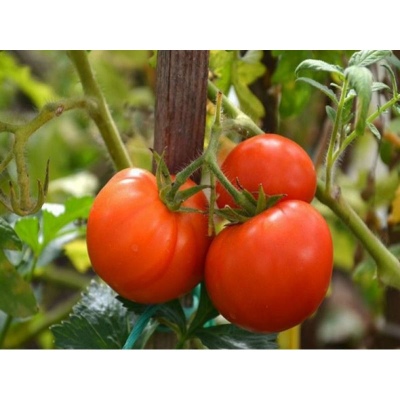
- Authors: domestic selection
- Name synonyms: Collective farm productive
- Category: grade
- Growth type: determinant
- Appointment: universal
- Ripening period: mid-early
- Ripening time, days: 100-105
- Growing conditions: for open ground
- Transportability: good
- Bush size: undersized
With all the promotion of foreign selection, domestic crop production does not lag behind in quality. The Kolkhozny tomato is convincing proof of this. That is why it is worth getting to know him better.
Description of the variety
Such a crop has an alternative name - Collective farm harvest tomato. It is characterized by the determinant of development. The variety is versatile in its purpose. It is mainly used for open ground. And it is in such conditions that he shows his best qualities, indeed, according to the name, suitable for an advanced economy.
The height of the bushes is no more than 0.6 m. Therefore, their placement in greenhouses does not create any difficulties. The bushes themselves have an average capacity, belong to the semi-spreading type. There will be a lot of branches, and a lot of foliage will also appear on them. But the stem will not be formed.
The main qualities of the fruit
The harvest of the collective farm tomato is easy to transport. When ripe, it has a bright red hue. The mass of a single specimen is 100-120 g. A round shape is typical for them. The berries will develop from simple inflorescences.
Taste characteristics
The collective farm tomato is sweet. At the same time, decent, powerful acidity is also noted. This combination is not for everybody. The smooth skin formed on the surface of the fruit does not adversely affect the overall taste. In any case, this is not mentioned in the official description.
Ripening and fruiting
The Kolkhozny tomato belongs to the mid-early category of varieties. Usually, between the appearance of early greens and the readiness of the fruit for harvest, it takes from 100 to 105 days. You can shoot berries in July, August and in the first third of autumn.
Yield
In terms of productivity, this variety is quite good. But it is worth emphasizing that in the available sources, exact collection figures are not given. There is only mention that it is stable over the years.
The timing of planting seedlings and planting in the ground
It is possible to grow a collective farm tomato both in seedling culture and in a seedless way. The second option is best suited for areas with mild climates and long summers. Depending on the conditions, sowing takes place from the end of April to June. Only those plants that have managed to get stronger can be transplanted into open ground.

Growing tomato seedlings is an extremely important process, because it largely depends on whether the gardener will be able to harvest at all. All aspects must be taken into account, from seedbed preparation to planting in the ground.
Landing scheme
A landing system of 600x600 mm is recommended. Other varieties with the same optimal placement order on the site, if they are found, are very rare.

Growing and care
You will have to tie up and shape the Kolkhoz tomato in any case. This variety tolerates late blight infection.But, as always, reinsurance measures and preventive treatments will not be superfluous. Whether to form the plants into 2 or 3 stems, you will need to decide for yourself. The culture can withstand heat, cold, and other influences that provoke the onset of plant stress - but still those owners who minimize these negative factors will benefit.
If tomatoes have already grown in the same place before, they can be planted again only with an interval of 2 or 3 years. Feeding with fresh manure is unacceptable, since it will lead to the activation of green mass and slow development of fruits. It is not necessary to remove too many leaves, because otherwise, instead of increasing the yield, you can lower it. It is quite enough to remove 2 or 3 leaves per week on the bush. It is much better, in general, to focus on the removal of stepsons.
Spraying with boric acid (diluted to 0.02%) enhances the formation of ovaries. It is advisable to choose fertile areas with loose soil. Before sowing, the seeds are treated with potassium permanganate, after which they are washed with clean cold water. With the threat of frost return, a temporary film shelter is formed using arcs.
Tomatoes should be fed twice or thrice during the growing season. In order for the collective farm tomato to give a good harvest, it needs active illumination by the sun. The holes are dug deeper so that the roots are free. Immediately after planting, the seedlings are watered abundantly. Regular loosening of the soil and the same systematic watering make it possible to count on enhanced bud formation.
For the first time, fertilizers should be applied 7 days after planting. Further feeding is carried out every 14 days. Complex mineral mixtures are best suited for them. Pinching of bushes is recommended at an early stage of development. It is best to do this over 4 or 5 sheets.
Later, if the bush is very stretched, cut off to 2/3 of the shoot. This technique allows you to activate budding. It is required to weed the plantings as they overgrow with weeds, and not when everything is started. Moisture retention is ensured by mulching with peat or straw. The best harvest is obtained when the bushes are formed with 2 or 3 stems.




A plant needs different micronutrients at each stage of growth. All fertilizers can be divided into two groups: mineral and organic. Folk remedies are often used: iodine, yeast, bird droppings, eggshells.
It is important to observe the rate and period of feeding. This also applies to folk remedies and organic fertilizers.



























































































